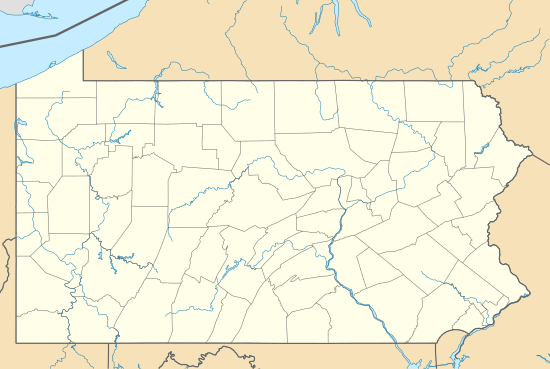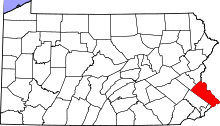Quakertown, Pennsylvania
| Quakertown, Pennsylvania | |
|---|---|
| Borough | |
|
Quakertown | |
| Etymology: the "Quakers" | |
| Motto: "The Heart of Upper Bucks County!" | |
 Location of Quakertown in Bucks County | |
 Quakertown Location of Quakertown in Pennsylvania | |
| Coordinates: 40°26′26″N 75°20′26″W / 40.44056°N 75.34056°WCoordinates: 40°26′26″N 75°20′26″W / 40.44056°N 75.34056°W | |
| Country | United States |
| State | Pennsylvania |
| County | Bucks |
| Area | |
| • Total | 2.0 sq mi (5 km2) |
| Elevation | 505 ft (154 m) |
| Population (2010) | |
| • Total | 8,979 |
| • Density | 4,500/sq mi (1,700/km2) |
| Time zone | EST (UTC-5) |
| • Summer (DST) | EDT (UTC-4) |
| ZIP Code | 18951 |
| Area code(s) | 215, 267 |
| Website | www.quakertownboro.com |
Quakertown is a borough in Bucks County, Pennsylvania, in the USA. As of the 2010 census, it had a population of 8,979.[1] The borough is 16 miles (26 km) south of Bethlehem and 29 miles (47 km) north of Philadelphia, making Quakertown a border town of both the Delaware Valley and Lehigh Valley metropolitan areas. Quakertown is considered part of the Allentown−Bethlehem urbanized area and the Philadelphia−Camden−Wilmington (PA−NJ−DE-MD) MSA.
History
Quakertown was originally settled by members of the Religious Society of Friends, or Quakers. The settlement was not officially known as Quakertown until its first post office opened in 1803.[2]
On September 18, 1777, during the American Revolutionary War, a convoy of wagons carrying the Liberty Bell from Philadelphia to Allentown, under the command of Col. Thomas Polk of Charlotte, North Carolina, stopped in Quakertown. The Liberty Bell was stored overnight behind the home of Evan Foulke (1237 West Broad Street), and the entourage stayed at the Red Lion Inn. The John Fries' Rebellion was also started in the Red Lion Inn in 1799.
In 1854, Quakertown elected its first Burgess. The North Pennsylvania Railroad caused a great increase in population, and by 1880, the population of Quakertown had almost reached 1,800.[2]
Liberty Hall, Quakertown Historic District, Quakertown Passenger and Freight Station, and Enoch Roberts House are listed on the National Register of Historic Places.[3]
-

Richland Friends Meeting House, the Quaker meeting house in Quakertown
-

West End Fire Company
Industry and population
The American Civil War along with national economic expansion changed Quakertown from a tiny village to a commercial manufacturing center. In the nineteenth century, local industrial establishments included cigar and cigar box factories, silk mills, harness factories, and stove foundries. Until 1969, Quakertown generated its own electrical power. The population of Quakertown in 1900 was 3,014; it rose to 3,801 in 1910. By 1940, the population had reached 5,150 people. At the 2010 census, the borough's population was 8,979.
Today, Quakertown has several restaurants, and businesses that line Pennsylvania Route 309.
Geography
Quakertown is located at 40°26′26″N 75°20′26″W / 40.44056°N 75.34056°W (40.440440, −75.340477),[4] at an elevation of 505 feet (154 m) above sea level.
According to the United States Census Bureau, the borough has a total area of 2.0 square miles (5.2 km2), all of it land.
Tohickon Creek, which drains into the Delaware River, flows past the northeastern edge of the borough.
Climate
| Climate data for Quakertown, Pennsylvania | |||||||||||||
|---|---|---|---|---|---|---|---|---|---|---|---|---|---|
| Month | Jan | Feb | Mar | Apr | May | Jun | Jul | Aug | Sep | Oct | Nov | Dec | Year |
| Average high °F (°C) | 33.0 (0.6) |
35.9 (2.2) |
46.1 (7.8) |
58.3 (14.6) |
69.3 (20.7) |
77.5 (25.3) |
81.5 (27.5) |
80.3 (26.8) |
73.3 (22.9) |
61.5 (16.4) |
48.8 (9.3) |
37.7 (3.2) |
58.6 (14.8) |
| Average low °F (°C) | 15.3 (−9.3) |
16.9 (−8.4) |
24.4 (−4.2) |
33.9 (1.1) |
44.2 (6.8) |
53.3 (11.8) |
57.1 (13.9) |
55.5 (13.1) |
48.3 (9.1) |
37.2 (2.9) |
29.9 (−1.2) |
21.0 (−6.1) |
36.4 (2.4) |
| Average precipitation inches (mm) | 3.1 (79) |
2.7 (69) |
3.7 (94) |
3.6 (91) |
4.0 (102) |
4.7 (119) |
4.5 (114) |
4.1 (104) |
4.0 (102) |
3.0 (76) |
3.7 (94) |
3.4 (86) |
44.6 (1,133) |
| Source: Weatherbase [5] | |||||||||||||
Demographics
| Historical population | |||
|---|---|---|---|
| Census | Pop. | %± | |
| 1850 | 242 | — | |
| 1860 | 528 | 118.2% | |
| 1870 | 863 | 63.4% | |
| 1880 | 1,769 | 105.0% | |
| 1890 | 2,169 | 22.6% | |
| 1900 | 3,014 | 39.0% | |
| 1910 | 3,801 | 26.1% | |
| 1920 | 4,391 | 15.5% | |
| 1930 | 4,883 | 11.2% | |
| 1940 | 5,150 | 5.5% | |
| 1950 | 5,673 | 10.2% | |
| 1960 | 6,305 | 11.1% | |
| 1970 | 7,276 | 15.4% | |
| 1980 | 8,867 | 21.9% | |
| 1990 | 8,982 | 1.3% | |
| 2000 | 8,931 | −0.6% | |
| 2010 | 8,979 | 0.5% | |
| Est. 2015 | 8,855 | [6] | −1.4% |
| Sources:[7][8][9] | |||
As of the census[8] of 2010, there were 8,979 people residing in the borough. The racial makeup of the borough was 90.6% White, 2.4% African American, 0.3% Native American, 2.0% Asian, 0.0% Pacific Islander, 2.7% from other races, and 1.9% from two or more races. Hispanic or Latino of any race were 6.0% of the population.
As of the census[8] of 2000, there were 8,931 people, 3,421 households, and 2,251 families residing in the borough. The population density was 4,424.7 people per square mile (1,707.1/km²). There were 3,631 housing units at an average density of 1,798.9 per square mile (694.0/km²). The racial makeup of the borough was 94.46% White, 1.20% African American, 0.13% Native American, 1.51% Asian, 0.06% Pacific Islander, 1.58% from other races, and 1.06% from two or more races. Hispanic or Latino of any race were 2.88% of the population.
There were 3,421 households, out of which 32.9% had children under the age of 18 living with them, 50.7% were married couples living together, 10.5% had a female householder with no husband present, and 34.2% were non-families. 28.3% of all households were made up of individuals, and 11.9% had someone living alone who was 65 years of age or older. The average household size was 2.52 and the average family size was 3.11.
In the borough the population was spread out, with 25.5% under the age of 18, 7.9% from 18 to 24, 32.2% from 25 to 44, 19.1% from 45 to 64, and 15.3% who were 65 years of age or older. The median age was 36 years. For every 100 females there were 95.9 males. For every 100 females age 18 and over, there were 92.1 males.
The median income for a household in the borough was $41,942, and the median income for a family was $51,194. Males had a median income of $33,697 versus $26,988 for females. The per capita income for the borough was $20,562. About 3.7% of families and 5.9% of the population were below the poverty line, including 7.0% of those under age 18 and 6.7% of those age 65 or over.
Transportation
Quakertown is directly served by four state highways. PA 309 passes through the western part of Quakertown as West End Boulevard and runs north to Allentown and south to Montgomeryville and Philadelphia. PA 313 begins at PA 309 in Quakertown and passes through the town on Broad Street, heading southeast to Doylestown. PA 663 heads west from Quakertown at the PA 309/PA 313 intersection and interchanges with I-476 (Pennsylvania Turnpike Northeast Extension) at the Quakertown interchange before heading southwest to Pottstown. PA 212 heads northeast from PA 313 in Quakertown and provides access to Riegelsville.[10]
Quakertown has intercity bus service provided by Trans-Bridge Lines to Bethlehem, Doylestown, and the Port Authority Bus Terminal in New York City,[11] and by Bieber Tourways to Philadelphia, Bethlehem, Allentown, and Reading.[12]
Quakertown had passenger rail service to Bethlehem and Philadelphia until July 27, 1981, when SEPTA ended service on all its intercity diesel-powered lines.[13] Due to the numerous industrial complexes in Quakertown, the borough currently has freight rail service provided by a branch of the East Penn Railroad.[14]
Quakertown has a public general aviation airport, simply named Quakertown Airport. The airport is not located in the Quakertown borough itself, but in neighboring Milford Township.[15]
Notable people
- Diane Bracalente, Olympic field hockey player
- Tim Lewis, former professional football player for the Green Bay Packers, assistant coach with Atlanta Falcons
- Louis Riddick, former professional football player for the San Francisco 49ers, on-air talent for ESPN
- Bill Mensch, microcomputer pioneer
- Ken Schroy, former professional football player for the New York Jets
- Hampton S. Thomas, Medal of Honor recipient in the American Civil War.[16]
References
- ↑ "Race, Hispanic or Latino, Age, and Housing Occupancy: 2010 Census Redistricting Data (Public Law 94-171) Summary File (QT-PL), Quakertown borough, Pennsylvania". U.S. Census Bureau, American FactFinder 2. Archived from the original on September 11, 2013. Retrieved August 11, 2011.
- 1 2 "History". Borough of Quakertown. Retrieved November 2, 2012.
- ↑ National Park Service (2010-07-09). "National Register Information System". National Register of Historic Places. National Park Service.
- ↑ "US Gazetteer files: 2010, 2000, and 1990". United States Census Bureau. 2011-02-12. Retrieved 2011-04-23.
- ↑ "Weatherbase: Historical Weather for Quakertown, Pennsylvania". Weatherbase. 2011. Retrieved on November 24, 2011.
- ↑ "Annual Estimates of the Resident Population for Incorporated Places: April 1, 2010 to July 1, 2015". Retrieved July 2, 2016.
- ↑ "Census of Population and Housing". U.S. Census Bureau. Archived from the original on May 11, 2015. Retrieved 11 December 2013.
- 1 2 3 "American FactFinder". United States Census Bureau. Archived from the original on September 11, 2013. Retrieved 2008-01-31.
- ↑ "Incorporated Places and Minor Civil Divisions Datasets: Subcounty Resident Population Estimates: April 1, 2010 to July 1, 2012". Population Estimates. U.S. Census Bureau. Archived from the original on June 17, 2013. Retrieved 11 December 2013.
- ↑ Google (November 21, 2013). "overview of Quakertown, Pennsylvania" (Map). Google Maps. Google. Retrieved November 21, 2013.
- ↑ "Doylestown/Flemington/New York" (PDF). Trans-Bridge Lines. Retrieved November 21, 2013.
- ↑ "Destination Philadelphia" (PDF). Bieber Tourways. Retrieved November 21, 2013.
- ↑ Williams, Gerry (1998). Trains, Trolleys & Transit: A Guide to Philadelphia Area Rail Transit. Piscataway, NJ: Railpace Company. p. 83. ISBN 978-0-9621541-7-1. OCLC 43543368.
- ↑ East Penn Railroad Map (PDF) (Map). DeskMap Systems. 2011. Retrieved December 12, 2011.
- ↑ Quakertown Airport | Bucks County Airport Authority
- ↑ "Hampton S. Thomas". Retrieved July 4, 2014.
External links
| Wikivoyage has a travel guide for Quakertown. |
| Wikimedia Commons has media related to Quakertown, Pennsylvania. |
 |
|
 | ||
| |
|
| ||
| ||||
| | ||||
| |


